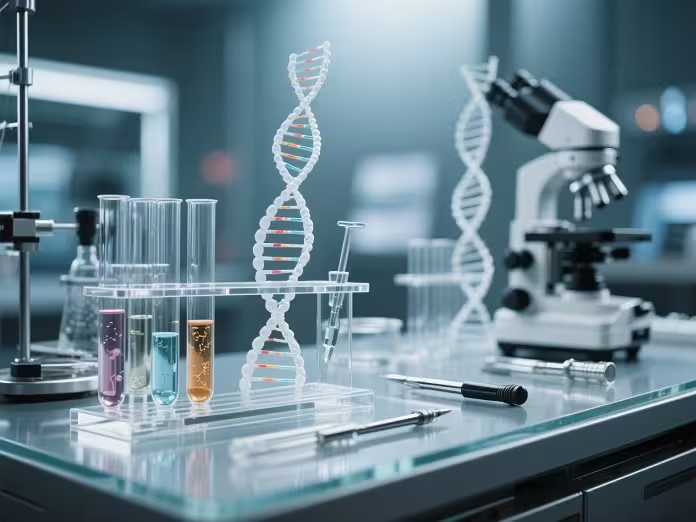
The human genome contains roughly 3 billion base pairs of DNA, each one a molecular instruction that shapes who we are. Today, scientists can rewrite these instructions with unprecedented precision, opening doors to miraculous cures while simultaneously raising questions that keep ethicists awake at night. Welcome to the revolutionary world of genetic engineering, where the line between healing and playing God has never been thinner.
“Gene Hacking Reality: Engineering Life’s Code.”
The CRISPR Revolution: Editing Life at the Speed of Light
Just two decades ago, genetic engineering was a laborious process that took months or years to accomplish. Then came CRISPR-Cas9, a molecular tool so precise it can edit individual letters in the book of life. This genetic engineering breakthrough has transformed laboratories worldwide, making gene editing as straightforward as using find-and-replace in a word processor.
The technology works like molecular scissors, cutting DNA at specific locations and allowing scientists to remove, add, or alter genetic sequences. What once required an army of researchers and millions of dollars can now be accomplished by a graduate student in a matter of days. This democratization of genetic engineering has accelerated research at breakneck speed, but it has also made the technology more accessible than ever before.
Medical Miracles: When Genetic Engineering Saves Lives
The promise of genetic engineering shines brightest in medicine, where it’s already transforming lives in ways that seemed impossible just years ago. Take sickle cell disease, a devastating genetic disorder that affects millions worldwide. Traditional treatments could only manage symptoms, but genetic engineering offers something revolutionary: a cure.
In groundbreaking clinical trials, doctors are extracting patients’ bone marrow cells, using CRISPR to correct the genetic defect, and returning the modified cells to the body. Early results show patients who have lived with chronic pain and organ damage suddenly experiencing normal, healthy lives. It’s genetic engineering at its most powerful – literally rewriting the code of life to eliminate suffering.
Cancer treatment has also been revolutionized through genetic engineering techniques like CAR-T cell therapy. Scientists extract a patient’s immune cells, genetically modify them to better recognize and attack cancer cells, then reinfuse them back into the body. These engineered cellular warriors have achieved remarkable success rates in treating previously incurable blood cancers.
Beyond individual treatments, genetic engineering is addressing global health challenges. Researchers are developing genetically modified mosquitoes that cannot carry malaria, potentially eliminating a disease that kills hundreds of thousands annually. Other teams are engineering bacteria to produce life-saving medications at a fraction of traditional costs, making treatments accessible to underserved populations worldwide.
The Dark Side: When Genetic Engineering Goes Wrong
However, the same power that makes genetic engineering miraculous also makes it terrifying. The technology’s precision can be its weakness – a single misplaced edit could have catastrophic consequences. Off-target effects, where genetic changes occur in unintended locations, remain a persistent concern that keeps researchers vigilant.
More troubling are the deliberate misuses of genetic engineering. The specter of biological weapons looms large, with the potential to create pathogens more deadly than anything nature has produced. The same tools used to cure disease could theoretically be used to create targeted biological agents, raising national security concerns that governments are only beginning to address.
Then there’s the question of enhancement versus treatment. While using genetic engineering to cure hereditary diseases seems clearly beneficial, what about enhancing human capabilities? The technology that could eliminate genetic blindness could also potentially enhance vision beyond normal human limits. Where do we draw the line between medical necessity and human enhancement?
Designer Babies: The Ultimate Ethical Minefield
Perhaps no aspect of genetic engineering sparks more debate than the possibility of genetically modified children. The technology already exists to edit human embryos, theoretically allowing parents to prevent their children from inheriting serious genetic diseases. But this same capability opens the door to “designer babies” – children whose traits have been selected or enhanced by genetic engineering.
The ethical implications are staggering. If genetic engineering becomes available to enhance intelligence, physical appearance, or athletic ability, will it create a new form of inequality? Will children whose parents cannot afford genetic enhancements be disadvantaged in a world where others have been genetically optimized?
Some argue that parents already influence their children’s genetics through partner selection and have a moral obligation to give their children the best possible start in life. Others contend that genetic engineering crosses a fundamental line, turning children into products to be designed rather than gifts to be cherished.
Regulatory Challenges in the Wild West of Genetics
The rapid pace of genetic engineering development has left regulatory frameworks struggling to keep up. Different countries have adopted wildly different approaches, creating a patchwork of regulations that scientists must navigate. While some nations have banned certain types of genetic engineering research entirely, others have embraced it with minimal oversight.
This regulatory inconsistency creates what critics call “jurisdiction shopping,” where researchers can simply move their work to countries with more permissive laws. The result is an uneven playing field where the most controversial genetic engineering research may be conducted with the least oversight.
International cooperation efforts are underway, but reaching consensus on genetic engineering regulations remains challenging when fundamental values about human nature and scientific freedom differ so dramatically between cultures and nations.
The Future Landscape: Balancing Promise and Responsibility
Looking ahead, genetic engineering will likely become even more powerful and accessible. New techniques are emerging that promise greater precision and fewer side effects. The cost continues to plummet, making genetic engineering tools available to smaller laboratories and potentially even individuals.
This democratization brings both opportunities and risks. On one hand, it could accelerate beneficial research and make genetic therapies more widely available. On the other, it increases the likelihood that genetic engineering will be used irresponsibly or maliciously.
The scientific community increasingly recognizes that technical capability must be matched by ethical responsibility. Leading researchers are calling for proactive governance frameworks that can adapt quickly to new developments while ensuring that genetic engineering serves humanity’s best interests.
Conclusion: Writing the Future of Life Itself
Genetic engineering represents perhaps the most powerful technology humanity has ever developed. Its potential to eliminate hereditary diseases, enhance human capabilities, and solve global challenges is matched only by its capacity for misuse and unintended consequences.
As we stand at this crossroads, the choices we make about genetic engineering will echo through generations. The question is not whether we should pursue this technology – that ship has already sailed. The question is how we can harness its incredible promise while avoiding its darkest perils.
The story of genetic engineering is still being written, and we are all its authors. The next chapter depends on our wisdom, our values, and our commitment to using this remarkable power responsibly. After all, when you’re rewriting the code of life itself, every edit matters.

































